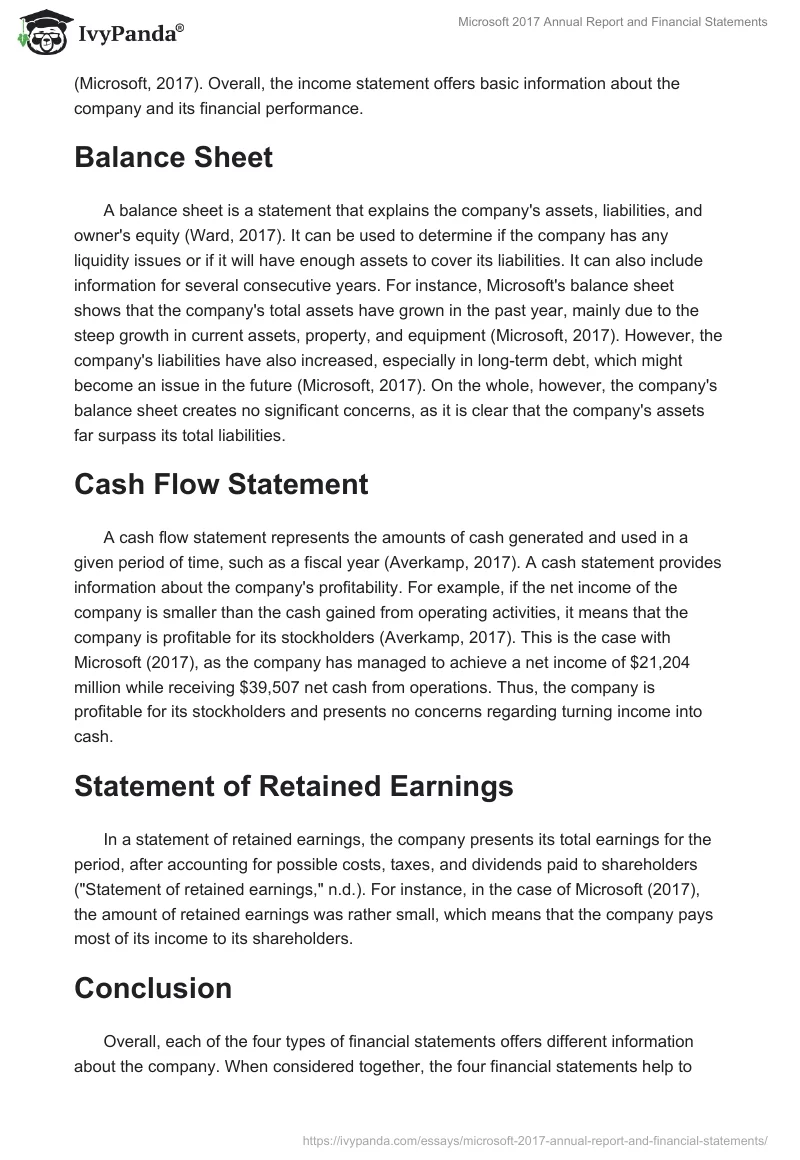Introduction
The four financial statements that are used by companies from various business sectors are the balance sheet, income statement, statement of cash flows, and statement of retained earnings. Each of these statements provides different information about the company’s financial performance. The present assignment seeks to explain the four types of financial statements using the Microsoft 2017 annual report.
Income Statement
An income statement is perhaps, the key part of the annual report, as it defines the company’s overall profitability. As explained by Bragg (2017), the income statement presents basic information about revenues, sales, and costs incurred by the company, which allows establishing the net income. In addition, the income statement presents information about taxes paid by the company (Bragg, 2017). This is especially important to international corporations like Microsoft that are subject to different levels of taxation in different parts of the world.
Microsoft’s income statement contains information about revenue, cost of revenue, operating income, taxes, net income, as well as earnings per share (Microsoft, 2017). The company also presents a horizontal analysis of information, which means that it includes data from previous years. This allows determining the overall trends, thus providing shareholders with substantial information about the company’s performance and development.
For instance, although Microsoft’s product revenue decreased in 2017 compared to 2016, the service revenue increased, which means that the company has been working on expanding its services sector (Microsoft, 2017). The net income of the company has grown substantially in the past two years, which means that the company was able to manage its expenses effectively to account for the reduction of product revenue (Microsoft, 2017). Overall, the income statement offers basic information about the company and its financial performance.
Balance Sheet
A balance sheet is a statement that explains the company’s assets, liabilities, and owner’s equity (Ward, 2017). It can be used to determine if the company has any liquidity issues or if it will have enough assets to cover its liabilities. It can also include information for several consecutive years. For instance, Microsoft’s balance sheet shows that the company’s total assets have grown in the past year, mainly due to the steep growth in current assets, property, and equipment (Microsoft, 2017). However, the company’s liabilities have also increased, especially in long-term debt, which might become an issue in the future (Microsoft, 2017). On the whole, however, the company’s balance sheet creates no significant concerns, as it is clear that the company’s assets far surpass its total liabilities.
Cash Flow Statement
A cash flow statement represents the amounts of cash generated and used in a given period of time, such as a fiscal year (Averkamp, 2017). A cash statement provides information about the company’s profitability. For example, if the net income of the company is smaller than the cash gained from operating activities, it means that the company is profitable for its stockholders (Averkamp, 2017). This is the case with Microsoft (2017), as the company has managed to achieve a net income of $21,204 million while receiving $39,507 net cash from operations. Thus, the company is profitable for its stockholders and presents no concerns regarding turning income into cash.
Statement of Retained Earnings
In a statement of retained earnings, the company presents its total earnings for the period, after accounting for possible costs, taxes, and dividends paid to shareholders (“Statement of retained earnings,” n.d.). For instance, in the case of Microsoft (2017), the amount of retained earnings was rather small, which means that the company pays most of its income to its shareholders.
Conclusion
Overall, each of the four types of financial statements offers different information about the company. When considered together, the four financial statements help to build a comprehensive profile of the company, which will be useful for investors, shareholders, and the general public. Microsoft has achieved good results in all the various aspects of financial performance in 2017, which is represented in its financial statements.
References
Averkamp, H. (2017). Cash flow statement. Web.
Bragg. S. (2017). The income statement. Web.
Microsoft. (2017). Annual report 2017. Web.
Statement of retained earnings. (n.d.). Web.
Ward, S. (2017). Balance sheet definition and examples. Web.

 4.50
4.50
